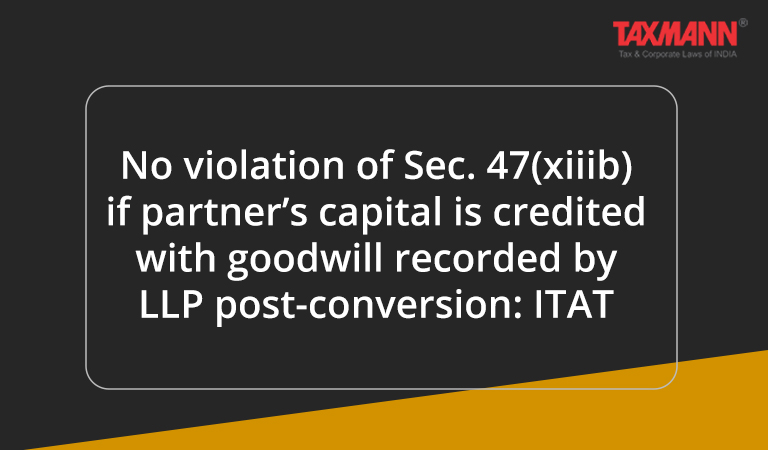No violation of Sec. 47(xiiib) if partner’s capital is credited with goodwill recorded by LLP post-conversion: ITAT
- Blog|News|Income Tax|
- 2 Min Read
- By Taxmann
- |
- Last Updated on 7 January, 2023
Case Details: ITO Vs. M/s Brizeal Realtors and Developers LLP - [2023] 146 taxmann.com 109 (Mumbai-Trib.)
Judiciary and Counsel Details
-
- Sandeep Singh Karhail, Judicial Member & Om Prakash Kant, Accountant Member
-
Dr Mahesh Akhade, CIT-DR for the Revenue.
Facts of the Case
Assessee was a Limited Liability Partnership (LLP) engaged in the construction activities. During the year, it was converted from a private limited company to an LLP post which a new partner was admitted to the LLP.
During the assessment proceedings, Assessing Officer (AO) noted that the current account of the existing partners was increased on account of goodwill on the admission of a new partner. AO opined that the amount credited to the partners’ account was in nature of a benefit as defined under clause (c) of section 47(xiiib). Thus, he denied the exemption under section 47 and made additions to the income as capital gains.
Being dissatisfied by the additions made, the assessee preferred an appeal to the CIT(A) who granted relief to it. Aggrieved-AO filed an instant appeal to the Mumbai Tribunal.
ITAT Held
The Tribunal held that the condition laid down in section 47(xiiib)(c) uses the word “shareholder ” and the shareholders of the company existed till the date of conversion. As soon as the registration from ROC as LLP was received by the assessee, the shareholders cease to exist but become partners of the LLP.
Since the share capital of the company becomes the capital contribution of the partners in LLP, the shareholders did not receive any benefit more than their share capital out of the conversion. The words “shareholder of the company” used in the section itself restricts the condition till the date of conversion of the company to LLP. Thus, goodwill arising out of the new admission of partner post-conversion cannot be treated as benefit out of conversion.
Further clause (f) of section 47 stipulates that no amount is paid to the partner out of the accumulated balance of the profits standing in the accounts of company as on the date of conversion within a period of 3 years from the conversion date. Since the accumulated profits in the company were negative, there was no scope for distribution of any amount from the accumulated balance of the profits.
Therefore, the exemption under section 47(xiiib) cannot be denied.
Disclaimer: The content/information published on the website is only for general information of the user and shall not be construed as legal advice. While the Taxmann has exercised reasonable efforts to ensure the veracity of information/content published, Taxmann shall be under no liability in any manner whatsoever for incorrect information, if any.

Taxmann Publications has a dedicated in-house Research & Editorial Team. This team consists of a team of Chartered Accountants, Company Secretaries, and Lawyers. This team works under the guidance and supervision of editor-in-chief Mr Rakesh Bhargava.
The Research and Editorial Team is responsible for developing reliable and accurate content for the readers. The team follows the six-sigma approach to achieve the benchmark of zero error in its publications and research platforms. The team ensures that the following publication guidelines are thoroughly followed while developing the content:
- The statutory material is obtained only from the authorized and reliable sources
- All the latest developments in the judicial and legislative fields are covered
- Prepare the analytical write-ups on current, controversial, and important issues to help the readers to understand the concept and its implications
- Every content published by Taxmann is complete, accurate and lucid
- All evidence-based statements are supported with proper reference to Section, Circular No., Notification No. or citations
- The golden rules of grammar, style and consistency are thoroughly followed
- Font and size that’s easy to read and remain consistent across all imprint and digital publications are applied








 CA | CS | CMA
CA | CS | CMA


